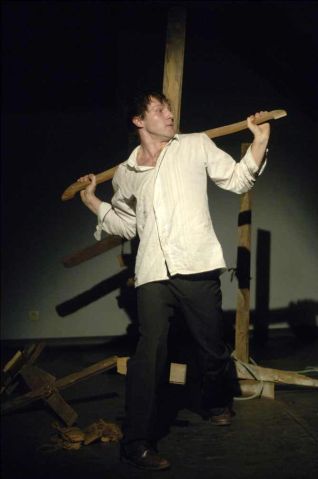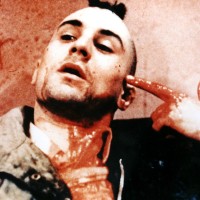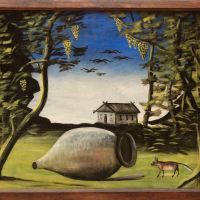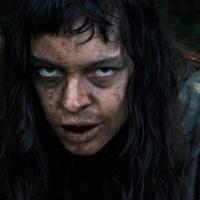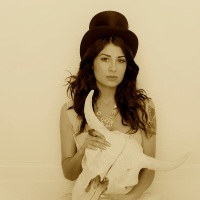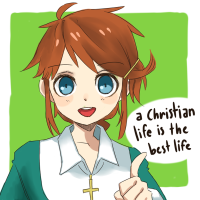Journey into European Puppetry #3: The Reality Principle
Notes from European Puppet Explorations in 2005
Part 3- The Reality Principle
…
We walked three floors up to an attic room with a pitched ceiling and exposed beams at l’École Nationale Supérieure des Arts de la Marionnette (ESNAM) in Charleville-Mézières, France. A Polish student, with the nearly unpronounceable name Przemyslaw Piotrowski, dragged in three scruffily constructed crosses as the room darkened. He also had several nameless placards like the one that read I.N.R.I. hanging above Christ on the cross. He handed one to an audience member with a faint smile foreshadowing death. He handed out another. Then he set up the crosses and began to reveal how each of these people died and their relationships. They were just people from his life. People he was intimate with. He was the crucifier. The story was predominately about his complicity in their deaths. In the end he crawls to a light emanating from a box. He finds a small door. He knocks on it and prays in Polish. Finally a dark eerie face comes to the window. But there is no sound coming from it. He finds that it is just a mask. But a mask for whom? He doesn’t know. He stops there waiting for an answer.
Before we can find out we descend again back to the long dark hall downstairs continuing on to the next student performance. This time we pass through the long blackened hall into a room where a woman is reading names and stories on a wall. It felt like autumn with dead twisted branches on the floor and walls and walnuts in rows on the ground. The voice continued reading from brown pages on the wall. It is the elfin black haired girl again. She is of Russian ancestry from Romania. Her name is Aurélia Ivan. When she introduced Julia’s piece she seemed shy and quiet with a whisper of a voice and an open smile. But now no one had any trouble hearing her strong words as she read from the wall in her dark dress while holding a wicker basket full of walnuts. She was transformed from petite girl with a gentle smiling face into the strongest of women. She spoke directly and with authority, but also quite sadly and compassionately. She finally leaned over while reading a list of attributes describing a proud man named Jean (John). She pronounced his final name, ‘Jean le mort.’ (John the dead.) Then she picked up a walnut and looked at it. She backed down this hall beckoning us to follow. The text was an extract from Valére Navarina’s longer dramatic work, La Chair de l’Homme (The Flesh of Man).
Aurélia then stood behind a wooden drawer that had been filled with sand. Then slowly she picked up a strange twisted root with a little plaster face attached to it. Faces inspired by the work of artist Jephan de Villiers. And she brought it slowly forward speaking in its voice. Then she planted it in the sand. Then she brought forth another root in a quite different shape with a different motion, with a different voice and planted that in the sand. By the time she was finished she had more than a dozen of these root creatures in this box carrying on a conversation in different voices about how they would eat the body below them. We followed her and walked through a jungle of phrases hanging from the ceiling which were in French and a little too poetic for me to quite understand. Finally we stood before long scraggly bare branches whose shadows grew as she waved her illuminated hands before them. Suddenly they seemed alive. She came to a door, rapped with her knuckles and it opened. She turned to us with her basket full of walnuts and bid us to leave through the door. As we left she handed us each a walnut, the fruit of decomposition, the possibility of something new.
I stepped outside into the light my head exploding with ideas. I viewed a few other student shows but these few quite exploded my concept of puppet theatre while confirming exactly why I had taken this journey. I had been attracted to the general idea of puppetry, suspecting that as an obscure art it contained ways of communicating that been barricaded in other art forms. Yet here was a form that could speak to children, everyone’s first prejudice about puppets, yet could also in the right hands deliver strong philosophical ideas as well. I didn’t necessarily agree with all of the content of what I saw. But I didn’t need to be kicked in the head to realize that this was indeed a powerful medium for ideas. And it had both ancient rules and a new vitality. It was also clear to me that it could communicate in a way that could possibly move beyond the postmodern dilemma. And this was the time to explore it.
The day ended with my talking to Julia Kovacs and Aurélia Ivan and photographing parts of their presentations after their evening shows had finished. As I was talking with Aurélia, who was quite serious and curious about why I had come all the way from Alaska to watch the student performances, there was an older French man who stood near us occasionally supplying French or English words to help the conversation along. As I was finishing my discussion with her she said “Oh! Do you know who this is?” Of course I didn’t. “His name is Francois Lazaro.” And then she proceeded to tell me he had been a teacher there for 15 years and had is own puppet theatre in Paris, the Clastic Theatre. And I turned and said, “So I guess should interview you?” He agreed and we set up a time the next day. And I walked back to the hotel that night, my head bursting with ideas, realizing that I had just had an unrepeatable day. I thought of the performances I had seen and the people I had met. And the way that puppetry could speak volumes in the right hands.
The next morning I met student Clea Minaker from Canada at a café for coffee and an interview. The first thing she said to me was that not all of the presentations were as serious or philosophical as the ones I had seen. The other set of performances had a lot crazier pieces. Her own piece was evidently built upon a mountain of consumer rubbish as she was coated in latex sheathes. (She had shown me the structure the evening before. A photo of the performance briefly glimpsed lead me to conclude that it must have been a wild piece.) Clea also explained the way the school worked. Oddly enough, there were only fifteen students in the school at any one time. The course lasted three years. And the same fifteen students moved together from an understanding of traditional puppet techniques, theatrical history, acting skills, experimental ideas and live performances. Several important European puppeteers passed through Charleville-Mézières with their shows. And the education was all for free, including the room and board. The students didn’t even need a college degree. They just needed to demonstrate their interest through past projects, speak passable French and survive the winnowing process. Clea also came back to the same line of thinking that Pascal in Paris had, that in today’s world puppet theatre provided a real tangible presence rather than yet another televised electronic spectacle. (Not that she was against puppet films.) The live performance was the chief importance of puppets in our times. So here at the International Institute for Marionettes it was quite clear that they were quite consciously leaning against the currents of the day. Clea certainly spoke of a profusion ideas herself and understood the importance of fighting against the tide of virtual electronic images to find something new. That is what struck me about the school in general: It was a place that profoundly encouraged intellectual searching and questioning in both a theoretical and a practical manner. These students truly were asking serious questions. Puppets were not seen as yet more mindless entertainment but as a means for provoking real thought.
Later I met Francois Lazaro for a beer in a café and we had a fascinating conversation about puppets, theatre and philosophical ideas. He had been performing puppet shows since 1966. We discussed his influences: Beckett, Švankmajer, even Tarkovsky. He also was quite aware of the special nature of puppets to reality in this media saturated age. For him puppets held revolutionary possibilities, not in the political sense, but in changing our view of things. He felt that traditional theatre had come to a dead end and was borrowing increasingly more from puppetry to stay alive. As we were talking Aurélia dropped in and joined the conversation. We all talked about the reality principle a little more. Aurélia was just as serious as Clea and Francois in her feeling that puppetry was a unique art form for the present moment. She planned on producing her own plays. And she had the intensity and commitment to pull it off. When she asked me how I even knew to come to see the students perform she locked eyes with me in a way that showed the need to have the question answered earnestly. She would be joining Francois’ troupe after graduation. These puppeteers understood the need for engaging the brain, a desperate shortage everywhere these days. They knew well that this world of simulated knowledge, cheap information and hollow entertainments could only be opposed by something as small, humble, tangible and intelligent as puppets. It was a way forward culturally, a way out of the maze, possibly a way to actually get people to laugh or cry or miraculously to reconsider their ideas, especially those created in virtual miasma of this 21st Century.
But many that are first shall be last; and the last shall be first. Matthew 19:30
(Next time we discover shadow puppets in Berlin and have a serious laugh.)
Byrne Power
Haines, Alaska
12/23/11
…………..
To learn more about Clea Minaker’s recent activities:
http://cleaminaker.wordpress.com/
And to see images from her 2005 ESNAM performance:
http://cleaminaker.wordpress.com/past-projects-2003-2007/
To discover what Aurélia Ivan has been doing since 2005:
http://www.facebook.com/pages/TSARA/206935446038225?sk=wall
To learn more about The Clastic Theatre this link might be helpful:
http://www.clastictheatre.com/
For more information about the Institut International De La Marionnette (en Français):
http://www.marionnette.com/fr/
And about ESNAM:
http://www.premiumorange.com/marionnette/pages_recherche/uk/esnam_cond_admiss_uk.htm
They used to have an English page but there are translation tools… Here is an English version of the course of study:
http://www.premiumorange.com/marionnette/pages_recherche/uk/esnam_prog_etude_uk.htm
